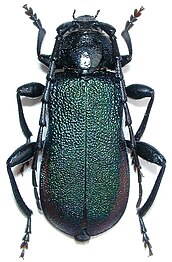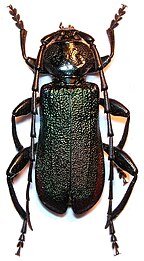| Ropalopus insubricus | |
|---|---|

| |
| Male Specimen of Ropalopus Insubricus | |
| Conservation status | |
 Near Threatened (IUCN 3.1) | |
| Scientific classification | |
| Domain: | Eukaryota |
| Kingdom: | Animalia |
| Phylum: | Arthropoda |
| Class: | Insecta |
| Order: | Coleoptera |
| Suborder: | Polyphaga |
| Infraorder: | Cucujiformia |
| Family: | Cerambycidae |
| Genus: | Ropalopus |
| Species: | R. insubricus |
| Binomial name | |
| Ropalopus insubricus Ernst Friedrich Germar, 1824 | |
| Synonyms | |
| |
Ropalopus insubricus is a rare species of European long-horned beetle in the family Cerambycidae. It was first documented by Ernst Friedrich Germar in 1824 and first assessed for the IUCN Red List in 2009. The species is quite rare in Europe and is classified as Near Threatened.
Description
Ropalopus insubricus is a species within the genus Ropalopus. It is characterized by its distinct morphological features. The species measures between 14 mm (0.55 in) and 31 mm (1.22 in) in length, it is identified by densely reticulated elytra lacking wrinkles in the basal half. The pronotum is unevenly tapered, featuring a large rhomboid area with slight punctation. In males, the lustrous pronotum contrasts with other subspecies, and the antennae are notably longer than the elytra. Pronotum stains are characterized by deeper punctation, narrow irregularities, and a non-merging pattern. Ropalopus insubricus is diurnal, with the species being particularly active during the warm daylight hours.
Life cycle
The life cycle of the Ropalopus insubricus beetle species spans 2 to 3 years. Adult beetles emerge ready to fly between May and August. The larvae of Ropalopus insubricus undergo development in damaged sections of living trees, pupating in the heartwoods under the bark. Observed variations in the pronotum and elytra shape, as well as the distinct body coloration, within the same population are likely a result of larval development and pupation occurring under the bark and inside the wood of living trees, exposing the immature stages to different pressures.
Distribution and habitat
Ropalopus insubricus, classified as an obligate saproxylic species, demonstrates a strong dependence on decaying wood throughout its life stages. Preferring mountainous environments, this species is prevalent from northern Italy through Slovakia to Hungary and the Balkans, extending into westernmost Turkey. The species is extremely rare only having two recorded occurrences in Turkey over the past 114 years. Host trees, particularly broad-leaved species such as Acer, Ficus, Fraxinus, Alnus, and Fagus, play a crucial role in supporting the life cycle of this species.
Ropalopus insubricus exhibits a degree of adaptability beyond montane habitats, as evidenced by its presence on road verges or Ficus plantations. Suspected to require a warm climate at low altitude for optimal development, Ropalopus insubricus is distributed across more temperate regions of Europe. Ropalopus insubricus can only be found at elevations lower than 600 meters (1968.5 feet) above sea level.
Conservation status
Ropalopus insubricus is classified as Near Threatened on the IUCN Red List due to the rarity of the species. Deforestation and forest fragmentation are contributing factors to its classification.
See also
References
- ^ Zicha, Ondrej. "BioLib: Biological library". www.biolib.cz. Retrieved 2023-12-25.
- ^ "Ropalopus insubricus". iucnredlist.org. Retrieved December 24, 2023.
- "Ropalopus ungaricus insubricus". www.cerambyx.uochb.cz. Retrieved 2023-12-25.
- ^ Karpinski, Lech; Szczepanski, Wojciech T.; Kruszelnicki, Lech (October 30, 2019). "Revision of the Ropalopus ungaricus/insubricus group (Coleoptera: Cerambycidae: Callidiini) from the western Palaearctic region" (PDF). Zoological Journal of the Linnean Society. 189 (4): 1176–1216. doi:10.1093/zoolinnean/zlz154 – via cerambyx.uochb.cz.
- Simon, A. (1954). "Note sur l'Éthologie de Rhopalopus Insubricus Germ. (Col. Cerambycidae)". Annales de la Société entomologique de France. 123 (1): 35–42. doi:10.1080/21686351.1954.12279073 – via Taylor & Francis Online.
- "Ropalopus insubricus". cerambyx.uochb.cz. Retrieved 2024-01-05.
- ^ "Ropalopus insubricus (Germar, 1824) - Xylophagous Insects". www.forestpests.org. Retrieved 2024-01-05.
- Paleart, Cerambycidae of the. "Longhorn beetle - Cerambycinae - Callidiini - Ropalopus insubricus insubricus Germar, 1824". Cerambycidae of the Paleart (in Czech). Retrieved 2023-12-25.
- Cebeci, Hüseyin; Özdikmen, Hüseyin; Turgut, Semra (February 6, 2011). "Callidiine species in Turkey with zoogeographical remarks and some interesting and rare records (Coleoptera: Cerambycidae: Cerambycinae)". Journal of Natural History. 45 (7–8): 475–483. Bibcode:2011JNatH..45..475C. doi:10.1080/00222933.2010.534193. S2CID 84403179 – via Taylor & Francis Online.
External links
| Taxon identifiers | |
|---|---|
| Ropalopus insubricus | |
This longhorn beetle article is a stub. You can help Misplaced Pages by expanding it. |

